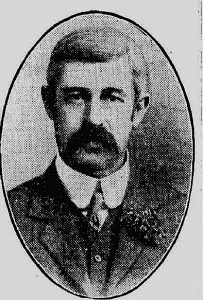By Lyn Collingwood, July 2023, Bulletin 5/2023.

After their marriage in January 1900 Henry Herron and Emily Ethel née Downie rented newly-built Divo (439 Glebe Point Road), and their first child was born there the following November. The house is the middle of a row today numbered 433-445 Glebe Point Road and identified by plaques bearing the original names Gaza, Favo, Edna, Divo, Cama and Boro. (An early transcription error is probably responsible for Alma being replaced by Abna.) The present street numbering was fixed by 1906.
The terrace was completed in 1899 by wealthy builder William Jarrett on land he had owned for more than a decade. Jarrett’s numerous houses in Glebe included his own home Venetia, a mansion on the nearby headland known locally as Jarrett’s Point.1 After his death in 1901 Jarrett’s widow and step-daughter moved from Venetia to Alma and much of his substantial real estate, including the slate-roofed brick ‘alphabet’ houses, was put up for auction. Within Gaza on the corner of Leichhardt St were five bedrooms and four reception rooms, and at its rear, a coach house and stables and a room for the stablehand. (The stables today accommodate people.) Each of the other houses contained four bedrooms and two reception areas.

The Herron family
The oldest of six sons, Henry Herron was born in 1866 to James Herron, a coastal steamer captain, and Janet née Young. The family was Presbyterian. At the time he was renting Divo, Henry was working as an insurance clerk and had just been appointed Grand Secretary of the Grand United Order of Odd Fellows. He held the position for 14 years before resigning to concentrate on business interests. A Lodge at Gundagai was named in his honour, and at his farewell banquet he was presented with an illuminated address, items of furniture and silver fruit dishes. In 1914 Henry went into partnership with Ernest Walter Bell as Herron & Bell fire assessors. His occupation at his death (on 12 July 1958 at Hydebrae, Strathfield) was retired fire assessor. His widow, born in 1878, died in 1971.
Born at Divo, eldest son Henry Cecil tried his hand at various business enterprises. His mother was one of his partners in the Halliday Engineering Company, registered in 1919 to repair and sell motor cars. Two years later, with his father, he established a carrying firm, the Denby Transportation Company. This enterprise failed and Henry Cecil was declared bankrupt in 1923. He died in 1980.
Second son Leslie James, born in 1902 after the family moved to Mosman, and educated at Sydney Grammar, graduated LLB from Sydney University where he played rugby, rowed and swam. In 1939 he took silk and in 1962 succeeded H V Evatt as NSW Chief Justice. Among the trials over which he presided were those of bank robber Darcy Dugan and Arthur Calwell’s unsuccessful attempted assassin, Peter Kocan. A life sentence delivered to Charles Ivan le Gallien for patricide resulted in a death threat and Herron’s bodyguard became his golf partner. His involvement in sports administration included presidency of the Australian Golf Club, NSW Amateur Swimming Association and NSW Rugby Union. Knighted in 1966, Sir Leslie Herron died in 1973, a year after his mandatory retirement. Like his father, he was a Freemason.
Also born at Mosman were Andrew John, Jeanette Emily and Mary Isobel. Albert Allan, born at Burwood in 1916, was educated at Sydney Grammar where he joined the cadets. He enlisted in 1940 and was amongst those captured defending Crete against the German invasion. Lieutenant Herron died as a prisoner-of-war in May 1941 and was buried in the Phaleron War Cemetery near Athens.
The Ayre family
After the Herrons moved to Mosman, Divo was rented by Emma Ayre, a widow. Aged 20, she had landed in Sydney in 1864 on the Wanata with her 23-year-old husband Jonas. They were assisted immigrants.
Jonas set up his home and cabinetmaking business on George St West (now Broadway) opposite the Colonial Sugar Refinery. He prospered as a skilled carpenter, displaying pieces of furniture in variously coloured inlaid woods at the 1877 Intercolonial Exhibition in Prince Alfred Park.
In 1895 and 1896 Jonas was an unsuccessful Outer Ward candidate for Glebe Council.
Having survived being trampled by his runaway horse some years earlier, he died in his sleep in November 1898. A land speculator, his holdings included land at Penrith and lots on Glebe’s Bay Street and Queen Street (Holmes Estate) and Charles Street (Briarbank Estate).
Emma Ayre died at Mosman in 1927 and was buried with her husband in the C of E cemetery at Rookwood. She was survived by her married children: Pethaina Henry, Isabella Walsh and Henry Midgley Ayre (who lived for a time at Har-Nat, 50 Toxteth Road). Ada Ayre had died as a baby in 1870 and 14-month-old Joseph Robert Ayre died in 1884.
Note 1: Jarrett’s story was a ‘Who lived in’ article in the Glebe Society Bulletin 1/2017.
Sources: Alumni Sidneienses; Australian Dictionary of Biography; NSW electoral rolls; NSW State Records; Sands Directories; Trove website.










There are no comments yet. Please leave yours.